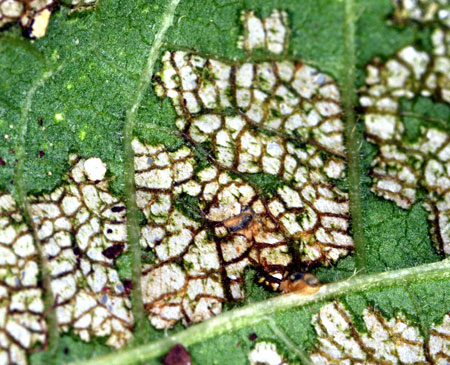Identifying critter damage in the garden and landscape
Whether it’s your vegetable garden, flowers or woody ornamentals, when foliage, flowers or entire plants are missing, the big question is “Who did this?”

If a gardener isn’t sure what pest is causing foliage, flowers or entire plants to go missing, time and effort can go into the wrong solution and the plant material keeps disappearing. The two divisions of pests for this article are vertebrates, such as deer, rabbits, woodchucks and chipmunks, and some kind of insect. It is important to realize that animal repellants will not repel insects. Insecticides almost never repel animals. Using the correct product is important. Try to figure out who your target is. Having a ten-power hand lens or magnifying glass can help you see more of what is really going on.
When looking at plant damage, think of the size of the animal. It is impossible for an animal to eat small holes in leaves or to just strip tissue away. An insect cannot consume entire leaves, veins and midrib included, but they can feed on plants at all heights. Animal damage above 3 feet high is often deer, but woodchucks can climb to eat leaves or fruit. Damage low to the ground can be any animal, and damage from insects and animals can occur overnight or during the day. These are the kinds of answers that Michigan State University Extension horticulture educators and Master Gardener hotline staffs give every day. Here is a quick look at some common problems.
Leaves
- Small holes in the middle of leaves or edges chewed, and edges of hole are leaf-colored: Insects
- Upper and lower leaf tissue removed, leaving just veins: Insects
- Tan leaf with top and bottom intact, but no tissue in between top and bottom: Insect
- Missing entire leaves with or without petiole, or connecting stem: Animal
- Petiole of tree leaf cut or damaged and found on the ground, yet leaf is healthy: Insect
- Missing parts of leaves, nothing left like leaf mid-vein: Animal
- Hosta leaves removed to their stems: Usually deer

Leaf skeletonizing characteristic of bean beetle feeding. Photo credit: David Cappaert, MSU, Bugwood.org
Needles
- Tips of spruce new growth is cut off and on the ground in the spring: Squirrels
- Ends of branches have needles partially removed or shoot is cut and on the ground: Deer
Entire plant
- Small transplants or seedling cut off at almost ground level: Cutworms
- Small, tender plants clipped off at ground level and missing: Animal
- Newly planted bulbs dug up and pushed aside: Raccoon or skunk
Flowers
- Missing entire flower and possibly stem: Animal
- Flower bud and stem gone: Animal
- Small, round, brown or black spots that look thin and dried out on mints and chrysanthemums: Insect
- Small, ragged or rounded holes in petals: Insect
Garden vegetables
- Tomatoes close to the ground have holes poked into them: Birds
- Vegetables or fruit touching the ground are chewed into on bottom side: Slugs
- Young green bean plants appear to be mowed down: Woodchucks
- Squash and pumpkin leaves with gray, wilted areas and holes late in summer: Squash bugs
Animal damage can be handled two ways: a fence or netting can be put up to keep the animal or bird out, or a repellant can be used to discourage animal feeding, but repellants do not work on birds. There are many more repellants created for ornamental plants than food plants. Be sure to read the label.
For insect problems, insecticidal soap will work on soft-bodied insects like aphids, spider mites and caterpillars, but not on hard-shelled beetles. Call the MSU Extension Garden Hotline at 888-678-3464 for help with your insect or animal problems.



 Print
Print Email
Email


